 I have no information on the SR series, but there's a couple of excellent web pages on them: SR-1 and SR-2 (external links).
I have no information on the SR series, but there's a couple of excellent web pages on them: SR-1 and SR-2 (external links).
| Camera (US) | Europe | Japan | Introduced |
|---|---|---|---|
| SR-2 | 1958 | ||
| SR-1 | 1959 | ||
| SR-3 | 1960 | ||
| SR-7 | 1962 | ||
| SR-T 101 | 1966 | ||
| SR-1s | 1967 | ||
| SR-M | 1970 | ||
| SR-T 100 | 1971 | ||
| SR-T 102 | early 1970s | ||
| SR-T 200, 201, 202 | mid 1970s | ||
| SR-T 303/SR-T 505 | 1973 | ||
| SR-T 100b | 1975 | ||
| SR-T 101b | 1975 | ||
| SR-T 303b | 1975 | ||
| SR-T 100x | 1977 | ||
| SR-T MC II | |||
| XK | XM | X1 | 1972 |
| XE-7 | XE-1 | XE | 1975 |
| XK-M | XM Motor | X1 Motor | 1976 |
| XE-5 | XEb | 1976 | |
| XD-5 | 1979 | ||
| XD-11 | XD-7 | XD | 1977 |
| NS | NS | XD-S | 1979 |
| XG-1 | 1979 | ||
| XG-2 | XG-E | 1977 | |
| XG-9 | XG-7 | 1979 | |
| XG-SE | NS | XG-E | |
| NS | X-7 | NS | 1980 |
| NS | NS | X7 black | 3/1980 |
| NS | NS | X7 silver | 3/1980 |
| X7A | NS | NS? | |
| XG-M | XG-M | X70 | 1981 |
| X-700 | 1981 | ||
| X-370 | X-300 | NS | 1984 |
| X-570 | X-500 | X-500 | 1983 |
| NS | NS | X-600 | 1984 |
| X-370n | X-300s | NS | 1997 |
| - | - | X-370s | 2000 |
| Camera (US) | Europe | Japan | Introduced |
| Body | Modes | Meter | Flash | DOF Prv | MLU | Info View | Mult Exp | Exp Lock | Mech Rls | Exp Comp | Batt | Timer |
|---|---|---|---|---|---|---|---|---|---|---|---|---|
| SRT100 | M | CLC | ISO/PC+7 | Y | ||||||||
| SRT101 | M | CLC | ISO/PC+7 | Y | Y | Y | Y+3 | |||||
| SRT101b | CLC | ISO/PC | Y | |||||||||
| SRT102 | CLC | ISO/PC | Y | Y | Y | |||||||
| SRT200 | CLC | ISO/PC | Y | |||||||||
| SRT201 | M | CLC | ISO/PC | N | Y | |||||||
| SRT202 | M | CLC | ISO/PC | Y | Y | Y | Y | ? | Y | ? | Y | Y |
| SRT303 | M | CLC | ISO/PC | Y | Y | A, S | Y | Y | Y | Y | ||
| SRT303b | M | CLC | ISO/PC | Y | N | A, S | Y | N/A | Y | N/A | Y | Y+3 |
| XE-5 | A,M | CLC | ISO | Y | N | S | ? | N | ? | ? | Y+3 | |
| XE-7 | A,M | CLC | ISO | Y | N | A,S+6 | Y | N | Y | +/- 2 | N+2 | Y+3 |
| XK | A/M+9 | CLC | ISO/PC+8 | Y | Y | +9 | Y | Y | Y+10 | N+2 | Y | |
| XD-5 | M/A/S | CW | ISO/PC | Y | N | A, S | Y | N | Y | +/- 2 | N+2 | Y |
| XD-11 | M/A/S | CW | ISO/PC | Y | N | A/S+1 | Y | Y | +/- 2 | N+2 | ||
| XD-s +11 | M/A/S | CW | ISO/PC | Y | N | A/S+1 | Y | Y | +/- 2 | N+2 | ||
| XG-1 | M/A+4 | CW | ISO/PC | N | N | S | N | Y | +/- 2 | N | Y+5 | |
| XG-2 | CW | ISO/PC | N | N | Y | +/- 2 | N | Y+5 | ||||
| XG-7 | CW | ISO/PC | N | N | Y | +/- 2 | N | Y+5 | ||||
| XG-9 | CW | ISO/PC | Y | N | Y | +/- 2 | N | Y+5 | ||||
| XG-A | A | CW | ISO/PC | N | N | S | N | N | Y+5 | |||
| XG-M | M/A | CW | ISO/PC | Y | N | A/S+6 | N | N | Y | +/- 2 | N | Y+5 |
| X-300 | A/M | CW | N | N | S | Y | Y | N | Y+ | |||
| X-370n | A/M | CW | N | N | Y | N | Y+5 | |||||
| X-370s | ||||||||||||
| X-9 | A/M | CW | Y | N | Y | N | Y+5 | |||||
| X-570 | A/M | CW | ISO/PC | Y | N | A/S | Y | N | Y+5 | |||
| X-700 | P/A/M | CW | ISO/PC | Y | N | A/S+6 | Y | Y+12 | Y | +/- 2 | N | Y+5 |
| Body | Modes | Meter | Flash | DOF Prv | MLU | Info View | Mult Exp | Exp Lock | Mech Rls | Exp Comp | Batt | Timer |
The model numbers of the SRT series are far more confusing. Common European models were SRT303, SRT101, SRT101b, SRT303b, SRT100, SRT100X. the SRT2xx are, however, *very* rare on the used market. I've tried to unravel the model number relations before.
I have NEVER seen an SRT without DoF preview. [Andrew S. Dixon (choronzon@gmx.de) June 2000]
And about SR-T 100 SR-T 102 SR-T 200, 201, 202, SR-T 100b SR-T 101b SR-T 303b SR-T 100x SR-T MC II, I don't see their names in Japan. But I know SR101 and SRT super was sold in Japan. Maybe some of above appeared as different names in Japan. In another say, all Japanese SRT series models are: SRT101, SRT super, SR505 (not SRT505), SR101. I don't think SRM is included in SRT series (TTL meter manual exposure series) because SRM is based on SR1s. [Ryugin (ryugin@peach.ocn.ne.jp) July 2000]
"X7" was released from Minolta Japan in March in 1980. It has A mode, that's all. Basically the camera seems to be close to XG-A which was sold in US market.
About more details, like all other old manual focus cameras, there were silver body and black body of X7.
But X7 black had a different finish on that looks.
X7 black had a action grip on a front and acute matte screen in a viewfinder.
X7 silver did not have both them.
X7 black's price was higher than X7 silver by 5000 yen. [Ryugin (ryugin@peach.ocn.ne.jp) Aug 2000]
| 2.3 SR series (SR-1, SR-2) |
 I have no information on the SR series, but there's a couple of excellent web pages on them: SR-1 and SR-2 (external links).
I have no information on the SR series, but there's a couple of excellent web pages on them: SR-1 and SR-2 (external links).
| 2.4 SRT series (SRT 100, SRT 101, SRT 102, SRT 200, SRT 201, SRT 202) |
The following information on some of the SRT series cameras has been borrowed from MUG: Minolta SR-T 100b, 101b and 303b specifications. Data? Supplied by bhat@cs.mu.OZ.AU
Type: 35mm single-lens reflexes with match-needle/manual exposure control.
Lens mount: Minolta SLR bayonet, 54 degree rotating angle; coupling for full-aperture metering and automatic diaphragm control with MC lenses (stop-down metering used for other Rokkor lenses); button for depth-of-field preview and stop-down metering.
Light-metering: Full-aperture TTL type with overlapping readings taken by 2 CdS cells mounted on pentaprism and circuited to provide optimum exposure in both flat- and most contrast-lighted situations; stop-down metering also possible.
Film-speed range: ASA 6 to 6400 set by selector on shutter speed dial.
Power: One 1.35V mercury cell, Mallory PX-625 or equivalent, contained in camera base.
Exposure control: Turning shutter-speed dial and/or lens aperture ring to align follower with meter needle visible in finder yields proper exposure according to metering system indication at the film speed set. Alignment may be disregarded for exposure adjustment or full manual control.
Metering and match-needle exposure range: EV 3 to EV 17 (e.g., 1/4 sec at f/1.4 to 1/1000 at f/11) at ASA 100 with f/1.4 lens.
Shutter: Horizontal-traverse mechanically controlled focal-plane type; speeds 1, 1/2, 1/4, 1/8, 1/15, 1/30, 1/60, 1/125, 1/250, 1/500, and 1/1000 sec plus bulb setting.
Mirror: Oversize quick-return type (PO value: 138mm; finder image cutoff negligible even with 1600mm f/11 RF Rokkor extreme telephoto).
Finder:Eye-level pentaprism type showing 94% of 24x36mm film-frame area.
Magnification: 0.83X with 50mm lens focused at infinity. Mat-Fresnel-field focusing screen with centered focusing aid; 3mm microprism spot in SR-T 100b and 101b, 2.5mm horizontal split-image spot surrounded by 1.5mm microprism band on SR-T 303b. Meter needle and circle-tipped follower for match-needle exposure control, coupled metering-range limits, and battery-check indication all silhouetted within the viewfield; shutter-speed scale and setting indicator visible below the frame in SR-T 101b and 303b; lens aperture set on most Minolta lenses appears above the fame in SR-T 303b.
Flash sync.: X or FP delay: Through separate PC terminals on SR-T 100b; 101b adds an X-sync. hot shoe; through single PC terminal or hot shoe on 303b; X contact: Electronic flash synchronizes at 1/60 sec. and all slower settings including B; FP contact: FP flashbulbs synchronize at all settings through 1/1000 sec. Hot shoe contacts disconnected when a unit not inserted.
Film advance: Lever type, single- or multiple-stroke, 150 degree winding angle after 20 degree engaged movement to allow offsetting from body. Advancing-type exposure counter resets automatically when camera back is opened. Safe Load Signal indicates film alignment and advancing condition on SR-T 303b. Multiple exposures possible with rewind button on SR-T 303b.
? Self-timer: On SR-T 101b and 303b only; lever-type, approx 10 sec. maximum delay.
Other: 4-slot take-up spool; ASA/DIN conversion scale on back cover; conversion scale surrounded by memo holder on SR-T 101b and 303b.
Dimensions: 145 x 47.5 x 95mm (5-3/4 x 1-7/8 x 3-3/4 in.) without lens.
Weight: SR-T 100b: 690g (24-5/16 oz.), SR-T 101b: 705g (24-13/16 oz.), SR-T 303b:710g (25oz.) without lens.
?
Focusing Screen: The SRT-201 also has the "Mat-Fresnel-field focusing screen with centered focusing aid; 3mm microprism spot"; The SRT-102 also has the "2.5mm horizontal split-image spot surrounded by 1.5mm microprism band".
Light Metering: With the SRT-100,101,102 and 201 (and possibly others?), stop down metering is only possible with Auto-Rokkor (designed for older SR-1, SR-3 or SR-7), or Manual Pre-Set lenses.
My SRT-201 has two "hot spots", labeled "XX" in the crude picture below:/----------------------\ | XX | | /--\ | | |oo| | | \--/ | | XX | \----------------------/The lower "hot spot" is more sensitive (by about a stop) than the upper.My SRT-101 is similar to the 201, but the disparity in sensitivity between "hot spots" is greater. This is a parts camera, so the meter may not be working well.
Interesting diagram. What it shows is exactly how the meter in your 201 is supposed to work!
These cameras used a system Minolta called "Contrast Light Compensation" or CLC. The meter cells were two CdS cells, mounted on little prisms that in turn were cemented onto the front and back upper faces of the pentaprism. The locations of these two cells correspond exactly to the "hot spots" in the diagram.
Minolta gave the "lower" cell more weighting (made it more sensitive) so that the meter would give more emphasis to foreground subjects when metering a conventional horizontal picture. This was intended to prevent a bright sky in an outdoor picture from fooling the meter into giving an underexposure. But Minolta went even farther than that...
The two cells were, supposedly, wired together in a "bridge" circuit, so that if the light falling on them was fairly equal they'd be given roughly equal weight... but as the lighting on them became increasingly different (more contrast) increasing weight would be given to the lower one. Hence the name "contrast light compensation." If I remember my Minolta lore correctly, early SR-Ts had a fairly strong change in compensation as the contrast increased. Later they trimmed it back so its effect wasn't as pronounced -- mostly to avoid problems when metering vertical pictures -- and it became less distinguishable from regular center-weighted metering.
Pretty clever system for its day, and as I recall from my SR-T101 it usually worked quite well. (The main problem with it was from a marketing point of view -- there was no way to incorporate "bells and whistles" that would let the consumers SEE what CLC was doing for them as compared to a conventional center-weighted system.) The main problem with it now is that the cement used to attach the little prisms to the main prism sometimes turns dark with age and throws off the sensitivity. That may be what's happening to your "parts camera." [Jim Williams]
Minolta made some cameras for JC Penny and Kmart type stores. They are equivalent to:
[Dave Kandz, dkandz@pobox.com]
| 2.5 XE series (XE-5, XE-7) |
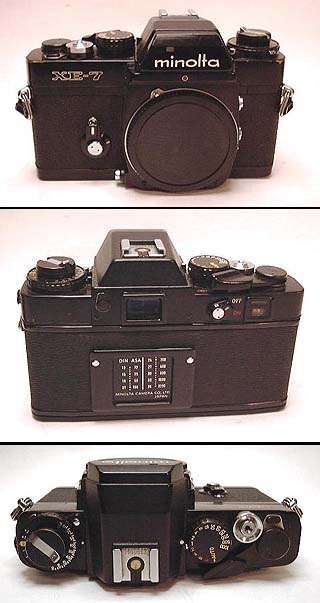 The XE cameras were an aperture prefered SLR. Top sync speed was 1/100 (I think) [actually 1/90 - Ed]. They looked like a Leica R3 for good reason, they shared some technology with the R3. They departed from the SRT's since they had a vertical metal shutter rather than the rubberized silk that the SRT's and the present X camera's have. They used the same CLE metering pattern that the SRT's used. They use MC mount lenses (they can also use MD's of course). They had a mechanical self timer and a film loaded indicator (similar to the SRT 202). The XE also had a stop down button for DOF preview. They took the same batteries as the XD or the X series so they do not require the mercury batteries. The XE-7 had a full info viewfinder, so you could see both the shutter speed and the aperture in the viewfinder, plus a viewfinder blind; the XE-7 also offered a multiple exposure facility not present on the XE-5 [doregan@ibm.net] The XE-5 did not have these viewfinder features. On the side of the XE is a little round red light that acts as battery check. The camera had a hot shoe on the pentaprism that was not dedicated. The XE-7 was all black, the XE-5 was a chrome body w/ a black pentaprism.
The XE cameras were an aperture prefered SLR. Top sync speed was 1/100 (I think) [actually 1/90 - Ed]. They looked like a Leica R3 for good reason, they shared some technology with the R3. They departed from the SRT's since they had a vertical metal shutter rather than the rubberized silk that the SRT's and the present X camera's have. They used the same CLE metering pattern that the SRT's used. They use MC mount lenses (they can also use MD's of course). They had a mechanical self timer and a film loaded indicator (similar to the SRT 202). The XE also had a stop down button for DOF preview. They took the same batteries as the XD or the X series so they do not require the mercury batteries. The XE-7 had a full info viewfinder, so you could see both the shutter speed and the aperture in the viewfinder, plus a viewfinder blind; the XE-7 also offered a multiple exposure facility not present on the XE-5 [doregan@ibm.net] The XE-5 did not have these viewfinder features. On the side of the XE is a little round red light that acts as battery check. The camera had a hot shoe on the pentaprism that was not dedicated. The XE-7 was all black, the XE-5 was a chrome body w/ a black pentaprism.
The line was supplanted by the XG line up. The XG's could take motor drives, something the XE's did not do. The XE's came out a litte after the SRT's were introduced in the early to mid seventies. [Phillip Taylor]
Sync is at 1/90; mechanical speed that can be used without batteries. Other speeds (4 sec to 1/1000) not available without batteries. Recommended shutter speed is visible in XE-5, but not aperture and setting (A or the manually set shutter speed) as in XE-7. [Barry Twycross]
Here's a big photo of the XE-1 from Peter Mattsson, Sweden (file size 48k; click your browsers' Back button to return to this page). The lens is an MC Rokkor-PF 50mm f1.7
Additional info [Dirk Bakker, 17/8/98]:
Another piece of useful information is that the XE-1's shutter has electronically controlled speeds in the range 1/1000 to 4 seconds, steplessly on automatic (aperture priority) mode, or in electronically controlled steps in manual mode. Feel free to add this info to the FAQ, as I think that it was not quite clear how it worked in regards to the "stepless" nature of the shutter speeds.I have taken some rather rudimentary measurements of my own to try and get a better idea of how the XE-1 does its metering. From this I get the impression that the XE-1 has an analogue version of what is commonly called matrix metering today.
I used a ceiling mounted light globe as a high intensity light source, and performed some crude and simple on-camera measurements by placing the light source at a matrix of locations in the viewfinder. The diameter of the light source was approximately the same as the diameter of the circular microprism focusing aid in the viewfinder. A 50 mm lens was used. The viewfinder was divided approximately into a 7x5 matrix (horizontally x vertically).
To start with, the light source was placed in the central location in the viewfinder, and it produced a particular shutter speed reading. This reading then became the reference for all the other measurements. When the light source was positioned at a different location in the matrix, the XE-1's exposure compensation dial (in EV) was adjusted to return the shutter speed indication back to the reference reading. The exposure compensation in EV over the full 7x5 matrix that was measured is provided below:
-2.00 -1.67 -1.00 -0.67 -1.00 -1.67 -2.00 -1.67 -0.75 -0.50 0.00 -0.50 -0.75 -1.67 -1.00 -0.67 0.33 *0.00* 0.33 -0.67 -1.00 -1.00 -0.33 0.50 1.00 0.50 -0.33 -1.00 -0.50 0.25 1.00 1.50 1.00 0.25 -0.50 In the above matrix of measurements, positive values imply that the light source was measured as being brighter than at the reference location, while the reverse applies for negative values.
Note that the measurement method is fairly crude, as the light source is not a true spot source, as there is a some light present in the background around the light globe. However, the light globe is still the most dominant source.
The number in the top left corner of the above matrix corresponds to the top left corner of the viewfinder. The number in the centre of the matrix corresponds to the centre of the viewfinder. And so on.
From the above data, it is evident that the XE-1's metering is less sensitive to light in the corners of the frame. However, it is interesting to note that, on and below the horizontal centreline, the metering is more sensitive to light on and either side of the vertical centreline. The sub-matrix of values that I refer to is:
0.00 0.33 *0.00* 0.33 0.50 1.00 0.50 1.00 1.50 1.00 When the camera is held horizontal, it appears from the above that the metering is weighted towards the foreground as well as any items in the centre of the viewfinder. If there is bright sky in the backround, in the upper 1/3 of the viewfinder, then this will not be weighted heavily by the metering.
The metering is definitely non-symmetrical about the horizontal centreline. If the camera is aligned vertically when taking a photograph, then it may help to know that the metering is more heavily weighted to the lefthand or righthand side, depending on the camera's orientation.
There is an excellent review of the XE series here (external link).
| 2.6 XK series |
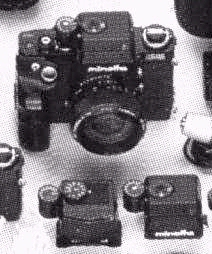 The XK, XK motor. Also known as the XM. These were the only Minolta cameras with fully interchangeable finders: unmetered prism, waist-level, high-magnification waist-level and two meter finders. The AE finder had CdS cells, the AE-S was one of the first silicon cell meters, with extended low-light abilities. These were averaging meters. And shutter speeds and apertures are visible in the viewfinder. There were also interchangeable screens, including two separate series of three microprism screens each, matched to wide, normal and tele lenses. One set of three screens has the microprisms set into clear glass, for maximum viewing brightness, the other set has them in ground glass. There were also the usual Minolta screens: plain ground glass, gridded ground glass, microprism with split-image center, clear glass with crosshairs. There was a hot shoe that clips on over the top of the rewind crank. These cameras had aperture-preferred AE and electronically controlled shutters. There is no advantage to using MD lenses instead of MC. They are battery dependent, even without one of the meter finders in place, except for B and 1/90.
The XK, XK motor. Also known as the XM. These were the only Minolta cameras with fully interchangeable finders: unmetered prism, waist-level, high-magnification waist-level and two meter finders. The AE finder had CdS cells, the AE-S was one of the first silicon cell meters, with extended low-light abilities. These were averaging meters. And shutter speeds and apertures are visible in the viewfinder. There were also interchangeable screens, including two separate series of three microprism screens each, matched to wide, normal and tele lenses. One set of three screens has the microprisms set into clear glass, for maximum viewing brightness, the other set has them in ground glass. There were also the usual Minolta screens: plain ground glass, gridded ground glass, microprism with split-image center, clear glass with crosshairs. There was a hot shoe that clips on over the top of the rewind crank. These cameras had aperture-preferred AE and electronically controlled shutters. There is no advantage to using MD lenses instead of MC. They are battery dependent, even without one of the meter finders in place, except for B and 1/90.
[Christopher G Mullin]
Here's an excellent page on the XK/XM/X-1 motorised camera (external link).
| 2.7 XD series (XD-5, XD-7, XD-11, XD-s) |
The XD cameras are one of the first ones to employ the shutter priority mode.
XD-7 / XD-11 Features
These features are a shorter version of the data contained in Minolta's
user's manual.
Type: Compact 35mm SLR Modes of operation: Manual metered; Aperture
priority (with MC/MD lenses) Shutter priority (with MD lenses)
Lens mount: Minolta SLR bayonet, 54 deg rotating angle
Light-metering: TTL, center weight, EV 1-18 uses silicon photo cell
Film speed range: ASA 212-3200
Autoexposure adjustment: +/-2 EV continuous adjustment of auto metered
manual with locks at 0, +/-1 EV and +/-2 EV.
Power: Two 1.5V silver-oxide cells power both autoexposure control
and shutter's electronically governed operation; LED's dim or do not light
signal batteries exhaustion; shutter will not release if voltage too low.
View finder: Eye-level pentaprism showing 94% of the 24X36mm film-frame
area; Magnification: 0.87X with 50mm focused at infinity; Fresnel-filed focusing
screen having matte filed plus central split-image horizontally oriented
focusing spot surrounded by microprism band; aperture shown optically; current
shutter speed shown optically in manual and aperture priority modes only;
the 'correct' shutter speed shown with LEDs on a scale at the right; this
scale is replaced with the 'correct' aperture scale in shutter priority;
over-under range indicators, also flash-ready indication for Auto 200X
Shutter: Vertical travel electronically controlled metal shutter.
Speeds: 1-1000 + X + B + O X - X sync = 1/100 sec (not metered) B
- bulb O = 1/100 sec O and B are the only modes in which the camera works
without batteries.
Lenses: Accepts all MC and MD lenses.
Flash: recommended flash: Auto 200X (dedicated). X sync = 1/100 sec.
hot-shoe & PC-terminal;
Film advance: Manual: lever type, single 130 deg stroke after 30 deg
unengaged movement; Motorized: with Auto Winder D; advancing type film frame
counter (no advance for multiple exposures); Safe load signal indicates correct
film transport and shows film advance.
Self timer: lever type with a maximum of about 10 sec delay.
Size & weight: 51x86x136mm without lens; 560g.
Accessories: Auto winder D, Auto Electroflash 200X, 50cm & 5m
remote cord, MD, MC Rokkor lenses.
Remarks:
An XD-5 is basically an XD-11 with a view finder window displaying the current aperture (only) [Dave Kandz].
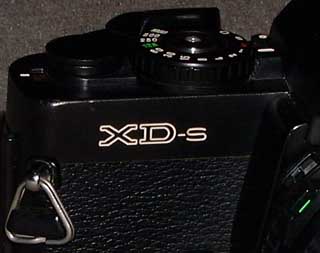 XD-s details:
XD-s details:
As XD, XD7, XD11 but with diopter adjustment to eyepiece and later Minolta logo [Mike Nobbs].
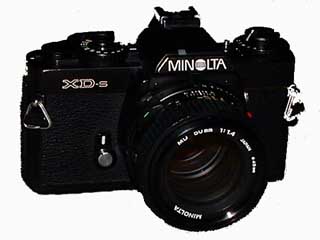
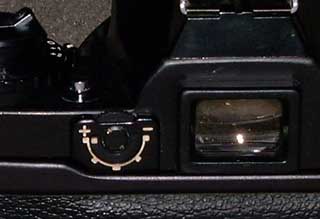
| 2.8 XG series (XG-1, XG-se, XG-1n, XG-2, XG-7, XG-A, XG-M, X-7) |
The information in this section has been provided by: Stephen D'Arcy-Evans.
XG series notes: All XG series bodies accept Minolta's Winder G. Only the XG-M of the XG series will accept the MD-1 Motor Drive, which was designed for the XG-M. X Flash sync on all XG bodies is 1/60 sec.
Features list:
XG-1: Modes: Aperture priority autoexposure and un-metered manual. Exposure compensation +- 2.0 in 0.5 steps. CW metered. Shutter speed range 4 sec to 1/1000 on auto, 1 to 1/1000 on manual + B mode. No DOF preview. Electronic selftimer. Shutter speed readout only in viewfinder. Accepts mechanical and Minolta electrical shutter release cords. No MLU. No multi exposure. No mech shutter speeds. PC cord socket.
XG-1[n]: adds film reminder / ASA to DIN converter chart on back, grip on front, as in XG-M. safe load signal also present (don't know if its on XG-1)
XG-se: another variant of one of the XG bodies; no idea what features are different. Was available in black.
XG-A: As far as I know, the same a XG-1 but without any manual shutter speeds. Retains Exp. comp. for some control though.
XG-M: Metered manual, DOF, interchangeable backs & viewfinder aperture added to XG-1[n] [Stephen D'Arcy-Evans] Only XG- series body that could take the Motor Drive 1.
XG-7: Is an XG-1 with two additions: it has that wonderful "film memo holder", and can accept a data back. [Dave Kandz]
XG-9: Is an XG-7 plus DOF preview, and viewfinder aperture window [Dave Kandz]
You actually can multiple expose with the XG-M. You just can't use exactly the same directions as you do for the SRT or other MF Minoltas. Usually, you just press the film rewind button, and then cock the camera. On my SRT's, pushing the rewind button disengages the sprocket and take-up spool (which advance the film) from the cocking lever, so that the film stays put while you cock the camera for the next shot. If you do all this with the camera back open and no film in the camera, the sprocket and spool will still turn, but very slight pressure from your thumb will cause them to slip. In my SRT's, the slight force required to pull film out of its cannister is enough to keep the film in place as the camera is cocked. You can throw a roll of outdated film in and test this procedure to see that it works. This method is suggested in the 101 manual.With the XG-M, first use the film rewind crank to gently wind the film backward BEFORE you push the rewind button, to take any slack out of the film. Then, you must push AND HOLD the film rewind button WHILE holding the film rewinding crank so that the film can't advance. It doesn't take much pressure on the crank to keep the film from advancing. The big difference between the SRT's and the XG-M seems to be in that, while pushing the rewind button still disengages the sprocket and spool from the cocking lever, the button pops back out again if you don't actually rewind the film right away. That doesn't happen with the SRT, and its why you have to keep holding the button in while cocking the XG-M. Also, the XG-M requires more force than the SRT to keep the film in place, so the force of the film being pulled out of its cannister isn't enough. That's why you also have to take the slack out of the film first, and then hold the rewinding crank in place while holding in the button and cranking.
Metering with CdS cell, EV 2-17, center-weighted (not the CLC system of XE and SR-T). Metring works only in automatic exposure, not in manual mode (the most idiotic system of the XG series). Aperture priority automatic exposure with stepless shutter speeds from 1/1000 to 1 sec. Manual shutter speeds in full EV steps from 1/1000 to 1 sec, but the meter does not work. Shutter is electronically controlled, horizontally travel focal plane shutter, made of cloth. No mechanical backup speeds, X-sync is 1/60 or slower. Bulb setting is electronic, too. Minolta X-type flash units can set the shutter speed automatically to X-sync.The viewfinder is fixed but has Acute-Matte focusing screen (brighter than normal), unlike the rest of the XG series. The screen has split-image center, surrounded by microprism and matte field, and it cannot be changed. There are readouts for set aperture (optically) and shutter speed the AE system is going to use (LEDs at the right side of the viewfinder - for full scale of shutter speeds, not like XG-1). These LEDs don't work when the camera is set to manual exposure. Over- and under-exposure warnings, flash ready-signal for Minolta X-type flash units.
Hot shoe and PC sync terminal. Stop-down button (the only XG body with it). Electronic self timer, delay is about 10 sec. 'Film memo holder' is a slot for the film box cover in the camera back. Safe-load signal (a control that shows the film is advancing properly). Size 52x88x138mm, weight 500g without batteries - two 1,5 v silver oxide, Everready s-76 cells or equivalent.
Accessories: Winder G and Data Back G.
The top-of the line body of the XG series. I have seen it only as chrome version.
X-7 black mentioned in this page is different model from X7A:
X-7A was released in 1990 and it's a version of X-370 (NOTE: a totally different camera).
X-7 was released in 1980 and it's a version of XG-A, one of XG series cameras which continued from late 1970 to early 1980's and was available as chrome body and black body. Black body was released later and it had a few improvements compared to chrome version. The improvements were:
1) installment of acutematte screen which was blighter than regular matte screen installed in chrome X-7.
2) Front grip added (like the X-700).
3) And a company name plate became new one "MINOLTA" from "minolta" which had been used on older cameras.
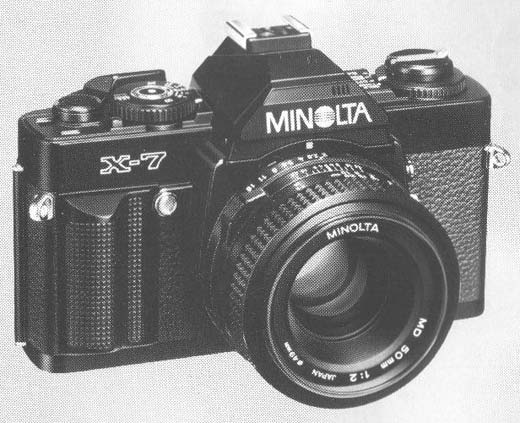

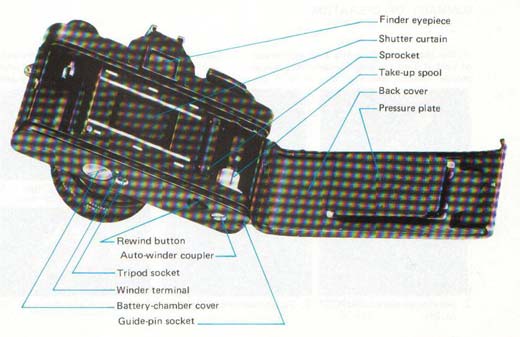
| 2.9 X series (X-370, X-370n, X-570, X-600, X-700, X-9) |
Most X series bodies (having been designed after the XG-M) will accept both the Winder G and MD-1, with the exception of the X-600. The newest body in the X series is the X-9, which is an X-370n with DOF preview. [Stephen D'Arcy-Evans]
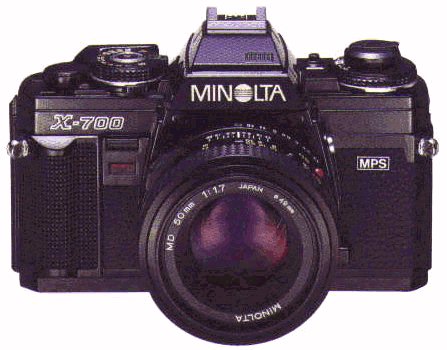
Modes: M A & P; Meter: full aperture, EV1 to EV18, AE-lock; TTL flash metering. DOF: yes; MLU: no; X-sync: hot shoe and PC socket, 1/60th; shutter: cloth, horizontal, speeds 4 to 1/1000th + Bulb; +/- 2 stop exp.comp.; film: 25 to 1600; screen: 9 types, "not user interchangeable"; Batt: 2x 1.5v LR-44 or A-76, 2x 1.55v silver oxide SR44, S-76 or EPX-76, or 1x 3v lithium CR-1/3N (camera unuseable without battery); 10 sec electronic self timer.
The very first examples of X-700, including the extremely rare silver version, did not have AE lock. The black version, with AE lock, was introduced in 1982 [ryugin@peach.ocn.ne.jp]
You can turn on the meter by pressing the AE-Lock switch momentarily. If you pull the AE-Lock switch up, you activate the self timer [Dave Kandz]
Slow Sync:
You can achieve slow-speed sync and still retain TTL flash metering with -PX series flashes by covering the left small contact (as seen from the back) on the hot shoe. This also works with Minolta's own dedicated off-camera flash cables. Slow-sync is possible by using the AE-L button before switching on the flash on the X-570. [Chris Valentine]
Multiple exposures on a single frame are possible by holding down the rewind button on the bottom of the camera whilst re-cocking the shutter. This also works for many of the SRT- series bodies. Its probably not accurate enough where you need precise alignment, but it does work. [Chris Valentine]
Flash Exposure Compensation:[Chris Valentine, from the MML]
Although, unlike many modern AF bodies, there's no button to allow you to do so, it is possible to adjust the exposure of the -PX series dedicated flashes when used on any of the X-500/570/700 TTL flash metering bodies. The easiest way is to make use of the camera's Manual metering mode because while in this mode, TTL flash metering still operates.
Hi,
The Hove book on X-700 says it is possible to change the split-prism focusing screen with another focusing screen. I would be interested in changing it to a diagonal split prism or a ground glass screen.Has anyone done this before? Is this a DIY or do I have to send it to the shop? and finally how much would have to spend?
You can do it yourself if you're careful. The changing mechanism is a lot like that on the Maxxum 9000, Pentax MX etc. -- the screen is held by a hinged frame with a latch in the front. Release the latch (with tweezers) and the frame hinges down; take out the old screen, put in the new one, and press the frame back up until it latches.
One problem is that (if I remember correctly) unlike the cameras designed for DIY screen changes, the X700 screens have no orientation tab on them -- it's all too easy to get them back in wrong, which will lead to inaccurate focusing. Also, getting the latching mechanism to latch is sometimes tricky. I remember that I once took the screen out of my X700 to clean it, and had an anxious 20 minutes or so of fiddling before I got it back together right.
I don't know what the going rate is now, but Minolta used to charge $35 to switch the screen and I'd think independent shops might be a little less (if you can find somebody willing to bother.) If you want a one-time permanent screen change I'd be inclined to spend the money just to avoid the risk of going through that scary 20 minutes again.
2.9.4 Feature comparison between X-5x0 and X-700
Date: Sat, 14 Nov 1998 10:12:00 +0900
From: RT (kn896839@kn2.so-net.ne.jp)
I have both X-500 and X-700. When battery becomes weak, X-500 shows you flashing M or A in the viewfinder. Still, the shutter works for a while. But X-700 switches off all the viewfinder indications such as P, A or M. Still, the shutter works for a while.When battery goes empty, at last X-500 switches off the viewfinder indication and the shutter stops.
X-600 was released in 1983 together with X-500 in Japan. As far as I know, this model was sold only in Japan, and one year after 7000 was released, this one was discontinued. Minolta made only ten thousand X600s in a few years (much fewer than other SLRs.)
X-600 has a focus aid function that Minolta calls Speed focus system. You can easily focus depending on LED indication in a view finder that shows you which way to turn a focusing ring. TCL module enables this function. TCL means Through the camera. This focusing sensor was made by one America's famous maker and Minolta developed a software that uses TCL module.
I believe that Minolta wanted to try their technology to make an AF camera by making this camera before they released 7000.I don't have X-600, but I know about this camera and I have seen this one several years ago.
Date: Fri, 18 Jun 1999
From: Alexander Karasev (alexander.karasev@gs.com)
The latest copy of PopPhoto has an interesting, if short, writeup on a first SLR Minolta ever sold that featured the AF sensor: Minolta X-600. Evidently a hair below X-700 as far as general specs, X-600 had a significant addition: a built in single horizontal AF sensor of the type subsequently used on the 7000, and three large LEDs in the viewfinder: two "out of focus" arrows showing which way to turn the ring to bring the subject in the AF sensor's view into focus, and a "focus confirmation" circle between them indicating when the accurate focus was achieved.The body was sold for about a year in Japan.
More X-600 details [Mike Nobbs]:
Date: Thur, 23 Mar 2000Speeds 1-1000 -1s,B Auto
Film 12 - 3200 ASA
Viewfinder, LED for film speeds as X-500,
no + or - comp.
no aperture setting visible
Focus indicated by 2 red LED arrows and central green dot
when focus correct and beeps
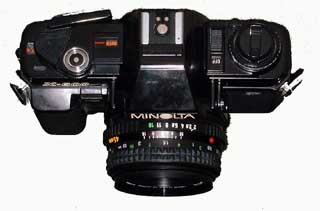
Takes TTL flash with PX
Takes Autowinder G but not Motor Drive 1
Takes MF back
Power from 2 AAA batteries in front RH hand grip
Electronic self timer and AEL
Matt screen with central rectangular sensor area
The mirror is etched as pic.
Minolta X-600 Focus Confirmation Sensitivity Tang/TabThe Minolta X-600 expects to receive lens 'speed' information from the lens via an additional 'tang' protruding from the lens into the camera body to push a switch.
The tang is at about 3 o'clock on the back of the lens (looking forward, as if taking a picture), INSIDE the outer lens mount ring (versus the MC and MD tabs which are outside the lens mount ring).
The Focus Confirmation Sensitivity switch is inside the camera body at about 9 o'clock inside the lens mount (looking at the camera front NOT as if taking a picture).
The switch chooses focus-confirm sensitivity between f/2.8 and faster/brighter position, and f/3.5 or slower/darker position (I have 2 Vivitar lenses with the tang in one position for the f/2.8 lens, and the other in the next position for f/3.5 lens).
I do not know how the camera behaves using SR, MC or MD lenses that do not have the auto-focus sensitivity tang.
Otherwise, the camera appears to be an X-500 with focus confirmation.
 The X-300 and X-370 are the base level bodies of the series and hence omit some of the features of the higher cameras. Most noteably missing is TTL flash metering. Some extra features, like a touch shutter button and exposure compensation, were added to the 300 to make the 370 and there are also 370s and 370n models.
The X-300 and X-370 are the base level bodies of the series and hence omit some of the features of the higher cameras. Most noteably missing is TTL flash metering. Some extra features, like a touch shutter button and exposure compensation, were added to the 300 to make the 370 and there are also 370s and 370n models.

...It is basically an X-370 w/DOF AND it has a "diagonal" split image viewfinder. The finish is "rubberized" where other models have the knurled plastic and smooth plastic where there is "leather" on the X-570's and 700's. Viewfinder "hump" has a smoother curve than other X-series, not an "angular" structure. Lens mount is standard Minolta stainless steel and it doesn't LOOK any flimsier than the others out there - in fact, sitting on my desk right now, next to the X-570 and one of my X-700's, it appears to have same chassis and frame as the others, the only really noticable difference being the smoother curve to the VF and the X-9 logo on the opposite side of the camera. I'm sure it will serve US well. (I just gone mine less than a month ago via EBay)
I ended up buying a new X-700 which is made in China. As you say, it has all the same functions as the Japanese model. There is a difference. The body of the Chinese model is made of a different type of plastic. The Japanese model (at least my old one) appears to be made of some kind of metal, and plastic. The Chinese model is all plastic. I don't think this is a big change. Even though the X-700 is an excellent camera, it doesn't have a solid, professional feel. I think this is why old SRT series cameras continue to sell in the used market.
Date: 27 June 2000
From: Andrew S. Dixon (choronzon@gmx.de)
This is subjective: When buying a Chinese X-700, caveat emptor! I've ended up with one having a slightly non-parallel focusing screen and bad mirror adjustment. Seemed to have a metal body though.
Seagull is located in Shanghai, China. Its SLR has market share of more than 50% in China. It is the first camera manufacturer passed ISO 9001 standard.
The Seagall DF-300 series licensed Minolta's X-series technology in early 80's. I dividing them into 3 groups:
MD lenses: 50mm f1.5, 50mm f1.4, 24mm f2.8, 28mm f2.8, 135mm f2.8, 500mm f7.7, 35-70mm/F3.5-4.9, 28-70mm/F3.5-4.5, 28-80mm/F3.5-4.8, 28-105mm/F3.5-4.5, 35-135mm/F3.5-4.5, 80-200mm/F4.5-7, 70-210mm/F4-5.6.
Seagull also makes rangefinder camera (205A), Twin Lens Reflex (4A-107,4A-105), digital camera, pointshot camera, flash, tripod, winder, filters, enlarger, enlarging lenses, Photo bags, and some non photo related stuff.Here is some information (may be a little outdated) on Seagull cameras:
Date: Tue, 31 Aug 1999 07:55:33
From: Mikko Niskanen (mikko.niskanen@turkuamk.fi)
The DF-300 is copy of X-series, ok, but the DF-200, 100 and 400 does not seem like a Minolta copy. There were no MF minoltas with vertical shutter and 1/2000 speed, as far as I know. And DF-2 then, it could be almost anything.
Details of the Seagull DF-200 SLR (27 Aug 2000)
Shutter: mechanical vertically travese metal blade shutter Shutter speed: 1 sec to 1/2000 and B Exposure mode: Manual mode only Self timer: Mechanical self timer about 10sec before a shutter release X sync: 1/125 or below Meter: TTL metering, 3 LED used in a view finder ISO range: 50 to 400 Mutiple exposure: capable Mount: MD Weight: 460g Standard lens: Seagull-610 50mm F1.8 MCBody is plastic. But, inside the body, metal is used. 94 percent of a real image shown in a viewfinder and viewfinder magnification is 0.9x. Acute matte focusing screen. When you use a selftimer, a mirror is locked up [note: may be mirror pre-fire like the Dynax 9]. But in Bulb mode, it does not. The camera does not have DOF preview button. [Ryugin (ryugin@peach.ocn.ne.jp) 27 Aug 2000]
Seagull DF2000 / DF99 spec
I got the camera's info from one Japanese website.
The spec is about Seagull DF99. According to the source, the camera is called DF2000 in China.
Interesting point about this camera is that the camera is electronically controlled but its exposure mode seems to be only manual mode. No description of Auto exposure mode.
Shutter: Quartz controlling vertical traverse cloth forcal plane shutter Shutter speed: Manually controlled, 1 to 1/1000 and B Self timer: electronically controlled. 10sec. before a shutter released. X Sync: 1/60 Metering method: TTL, it has three LED in a viewfinder. Mount: MD[Ryugin (ryugin@peach.ocn.ne.jp) 29 Aug 2000]
Here is the URL of the English version of the Seagull products website:
http://www.camerachina.com/frame/frame-introduct.htm
 Left is an X-370 clone, with Minolta MD lens mount, from Soligor.
Left is an X-370 clone, with Minolta MD lens mount, from Soligor.
 Samsung now (May 2001) make a clone of the X-700 body plus some matching MD lenses in Korea (see right). Click for a larger view: note the Samsung logo in place of the MPS symbol of the Minolta-origin version. (Photo provided by Mohammad Pakuwibowo)
Samsung now (May 2001) make a clone of the X-700 body plus some matching MD lenses in Korea (see right). Click for a larger view: note the Samsung logo in place of the MPS symbol of the Minolta-origin version. (Photo provided by Mohammad Pakuwibowo)
JAY PIPER (piperjay@VERSAR.COM) wrote:
Leica and Minolta worked together in early '80's to make:
- The shutter used on XE-5 and XE-7 (XE-7 was adapted into the Leica R-3; and also R-4 I think, maybe XD-11 was used for R-4 body castings?)
- Minolta/Leica CL rangefinder camera with Leica rangefinder mount Rokkor lenses - at least 3 different leica mount CL Rokkors were made (see the CLE FAQ).
- I think a few Minolta lenses -- the 800 and longer mirror lenses -- were sold in Leica reflex mount
XE-5 and XE-7 are quiet cameras, x-sync and bulb work w/o battery, still use my XE-7 after almost 20 years
For my knowledge the R3 is more or less identical to the XE-1/XE-7, except metering and lens mount.Also the R4 is is more or less identical to the XD-7/XD-11. Even the R-7 and R-6.2 were based on the XD-7/XD-11. You can easily see it, when you compare a R7 with a XD-7.
There are also some lenses, Leica "borrowed" from Minolta:
That are the 4.5/75-200, 4/70-210, 3.5/35-70, 2.8/16 Fisheye and the 2.8/24. Maybe there are some others, I don't know of.There was also a Leica/Minolta-cooperation regarding the CL/CLE rangefinders.
Here's what I've gathered:
- Minolta and Leica had a technology-sharing arrangement in the late 1970s, continuing into the 1980s. One of the first products from this was the Leica CL rangefinder camera, which was designed (mostly) by Leica and manufactured by Minolta; it was also sold under the name "Leitz/Minolta CL." (I had one of the Leitz/Minolta-badged versions; these tend to be later production and are more reliable than the Leica-badged ones.) Although I believe Leica made its own lenses for the CL, Minolta made the lenses sold for this camera that were sold under the Minolta Rokkor brand name; they also sold the 90mm f/4 Leica lens under the Rokkkor name, which is perhaps the only time in history that Leica has allowed one of its lenses to be sold under a different brand!
(The later Minolta CLE rangefinder camera was a 100% Minolta product, with no Leica involvement; it had an improved rangefinder, an electronically controlled shutter based on the one used in the XG-7, and a very advanced off-the-film-plane metering system for both ambient light and flash. In terms of metering sophistication, it's the most advanced rangefinder-type camera ever produced, topping any Leica M model and the Contax G series cameras.)
- When Leica wanted an electronically-controlled SLR to replace the SL2 series, they turned to Minolta for design expertise. The Leica R3, their first SLR with an electronic shutter, was manufactured by Leica, but used the complete chassis design of the then-current Minolta XE-7. The only major changes Leica made to the XE-7 were to redo the diaphragm actuator mechanism (to incorporate the push-pull action used on Leica lenses instead of the sideways action of Minolta lenses) and redesign the metering system to add spot metering capability. Other than that, the internal mechanics are pure Minolta.
- During the same time period, Leica sold various Minolta-made but Leica R-mounted lenses under the Leica name; they've been identified in another post.
- Subsequent Leica SLRs have also been based on Minolta XD-series mechanical designs, although with Leica-engineered electronics and metering systems. (Interestingly, the electronics are the most likely trouble spot on R Leicas!) According to the British magazine 'Practical Photography', the recently introduced Leica R8 is the first R-series Leica that does *not* use a Minolta-derived chassis!